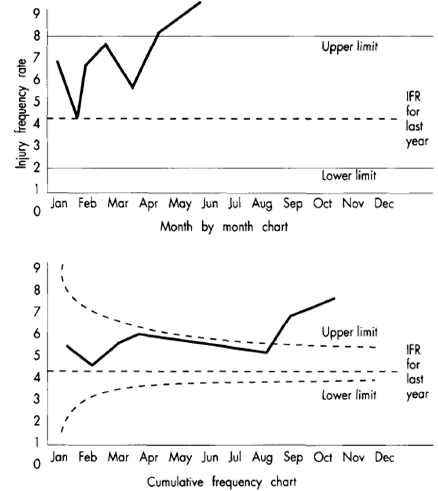SKEDSOFT
Introduction:
The use of statistical techniques based on frequency rates is inappropriate in the context of TQM. Frequency rates are descriptive statistics and as such they have no power in determining performance improvements.
Accident frequency rate charts

- Figure illustrates a typical accident frequency rate chart which can be obtained by plotting frequency rates of monthly recordings.
- The dotted line represents the mean frequency rate of the previous year
- There are three major statistical techniques used for the purpose of measuring failure rate. These include the following:
1. Frequency rate = the number of disabling injuries per million employee hours.

2. Incident rate = No of recordable injuries and illnesses for every 200,000 hours that are worked by employees.

3. Severity rate = Number of days charged for lost-time injuries per million employee hours worked.

These statistics may be useful in specifically analyzing failure frequency. They do however suffer from a large number of shortcomings which include the following:
- They are unable to measure performance since they are only descriptive in nature by providing comparative figures from year to year;
- Frequency rates do not reflect the overall safety performance standard companywide;
- FR provides overall statistics of accidents without pinpointing level of impact and degree of harm both short term and long term;
- FR is open to subjective interpretation since they do not provide an insight into the processes of hazard development which subsequently led to failures taking place;
- The standard used (mean of previous year’s FR) can be misleading if it is interpreted as the standard to achieve;
- FR does not reflect true cost resulting from various losses. They measure cost of days lost but not opportunity costs, human costs in terms of poor morale, negative attitudes, etc.;
- FR are absolute measures and do not look at failure in terms of the complex processes which lead to accidents. They do not identify the near misses, the minor injuries which do not have to be recorded legally and do not take into account unreported incidents.
In the context of TQM therefore, FR are unacceptable since they focus on failure. Zero Risk as a principle seeks to eliminate failure all together.